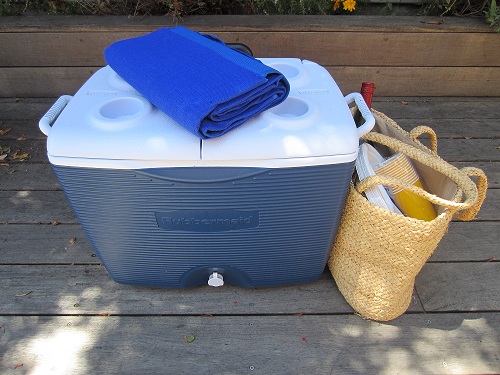Simple Tips for Summer Food Safety
 Monday, August 20, 2012 at 4:00AM
Monday, August 20, 2012 at 4:00AM 
By Sandy Hu
The other day, I told my optometrist I was working on a blog post about summertime food safety and immediately she chimed in with, “Don’t leave the potato salad in the car!” Like my optometrist, we’ve all learned a few food safety tips along the way.
But for an in-depth look, I turned to an expert, my friend Laura Brainin-Rodriguez, who has a Master’s Degree in public health, a Master’s Degree in nutritional sciences and is a registered dietitian. Here’s an astounding statistic Laura shared with me: The Centers for Disease Control (CDC) noted that in 2010, one in six Americans got sick from foodborne illnesses, and most frequently during the summer.
With Labor Day picnics, potlucks and get-togethers still ahead, it’s good to be mindful of small things we can do to help us keep our food safe. How you plan and prepare for your outing is key, Laura explained. It just takes a bit of conscious thought.
Remember that protein items are the most vulnerable, and meats with the most exposed surfaces like slices of cold cuts (versus a hunk of steak) have more surface area exposed to bacteria that can increase chances of foodborne illness if the protein food is not properly chilled. “Low-protein foods like fruit salads are less likely to go bad,” Laura notes. “And pickled foods (pickles, kimchi, and sauerkraut) go through a natural fermentation process that produces beneficial organisms to keep in check the bacteria that are likely to give us trouble,” she added.
Before you go:
- Have two insulated coolers: one for beverages and one for raw foods. When people constantly open the cooler for drinks, the internal temperature of the cooler will begin to warm up. Make sure you have enough ice or dry ice to keep foods at 40 degrees F. or below.
- The most important step to preventing foodborne illness is cleanliness at home: wash your hands well with soap and water and dry with a paper towel before prepping and cooking.
- If you are taking cooked foods, such as fried chicken, set the freshly cooked pieces in a single layer on a baking sheet, and as soon as no longer hot, cover and refrigerate in a single layer to chill quickly and thoroughly. You want to chill the food as fast as possible but putting hot food in the refrigerator will only bring the refrigerator temperature up.
- A word about mayonnaise: commercial mayonnaise is pasteurized. Concern has traditionally been over raw egg yolks that could provide a culture medium that could support the growth of bacteria that can give you a foodborne illness. Commercially produced mayonnaise is not implicated.
- When packing, store raw meat in plastic zipper bags or in airtight containers so the juices don’t leak and contaminate other foods – especially those that will be eaten without further cooking, like a green salad or fruit.
- Don’t pack your food until you’re ready to leave for your outing. Foods that sit for a long period in an insulated cooler will gradually lose their chill.
- Pack a clean platter to serve meat that you plan to cook at your destination; never put cooked meat back into the container where raw meat was stored.
At your destination:
- Remove your coolers immediately from the car and set them in the shade; even insulated coolers will begin to warm up if they are out in the hot sun.
- If you are using a public grill, bring your own cleaning supplies to clean the grill thoroughly before use.
- Wash hands with soap and water and dry with a paper towel before cooking.
- Be careful that raw meat juices on the cook’s hands don’t transfer to plates and utensils that will come in contact with cooked food.
- Cook just as much as everyone can eat, rather than cooking a big batch and leaving it on the table. Keep raw foods in the cooler, cooking as you go.
- The CDC recommends cooking meat to 145 degrees F. for whole cuts, 160 degrees F. for ground meat and 165 degrees F. for poultry.
- Discard any meat marinade; do not re-use it as a sauce unless you’ve boiled it thoroughly.
- Never leave foods sitting out on a picnic table for people to nibble at their leisure. As a general rule, Laura would return everything to the cooler within 30 minutes, once everyone is served.
Special Fork is a recipe website for your smartphone and PC that solves the daily dinnertime dilemma: what to cook now! Our bloggers blog Monday through Friday to give you cooking inspiration. Check out our recipe database for quick ideas that take no more than 30 minutes of prep time. Join the conversation on Facebook and follow us on Twitter.
Related posts:
Reader Comments (1)
A food safety culture is the expression of traditional values and beliefs. It represents the "flywheel of conventional thinking" among a working group. Thanks for the useful tips.